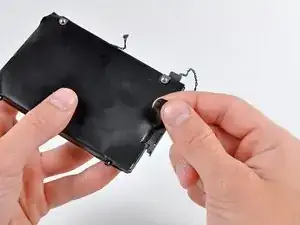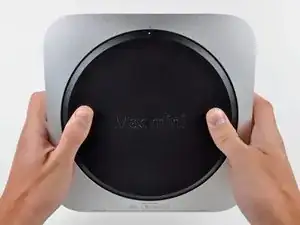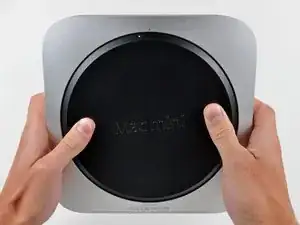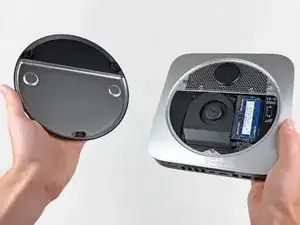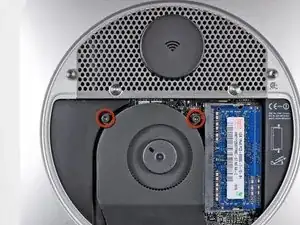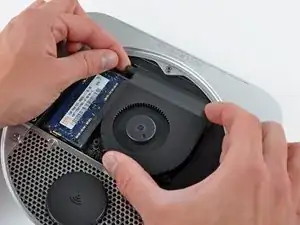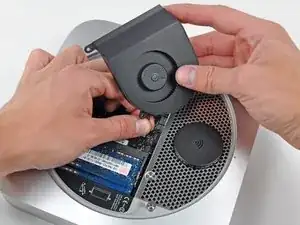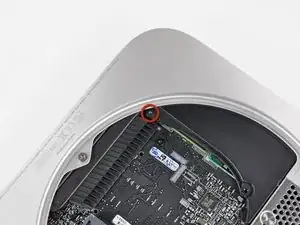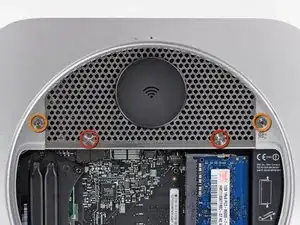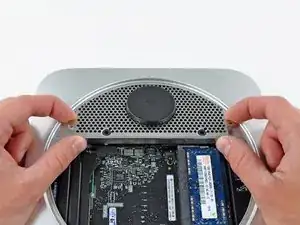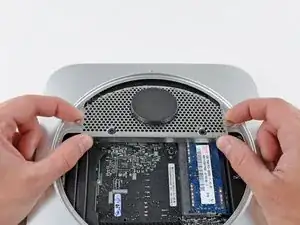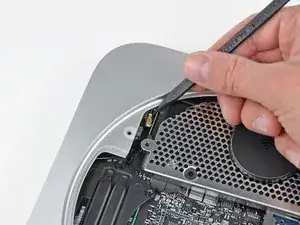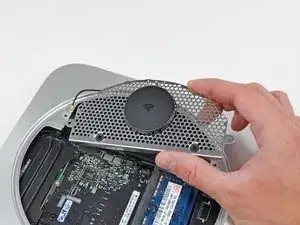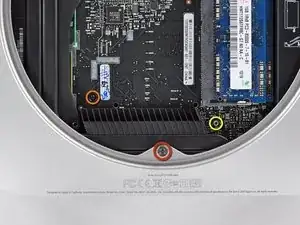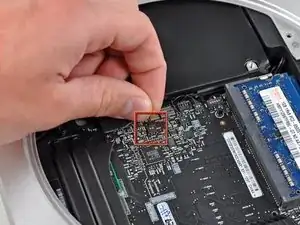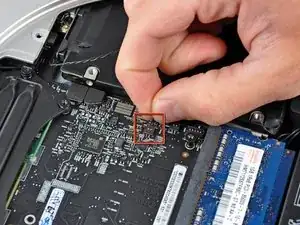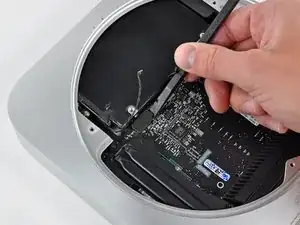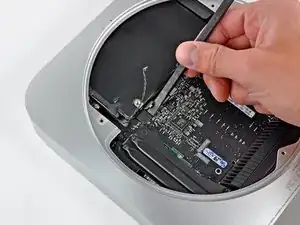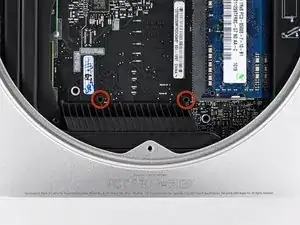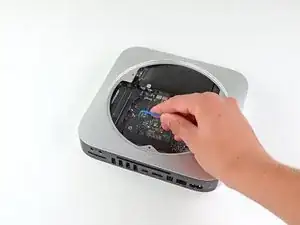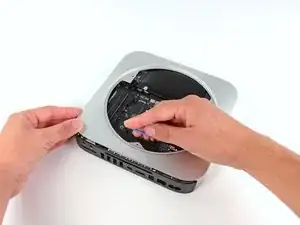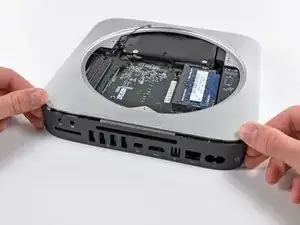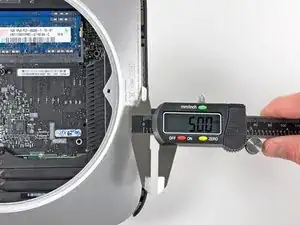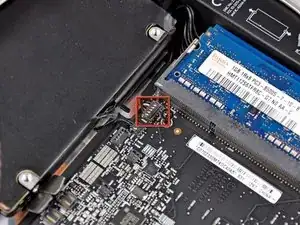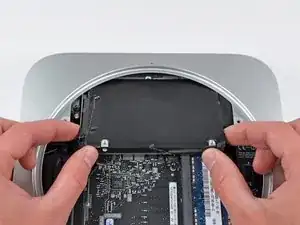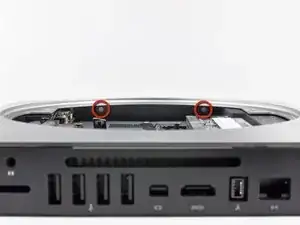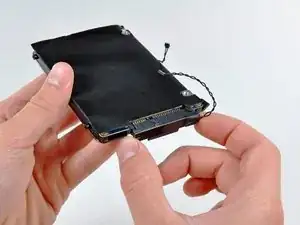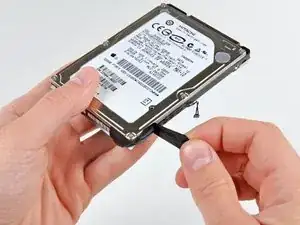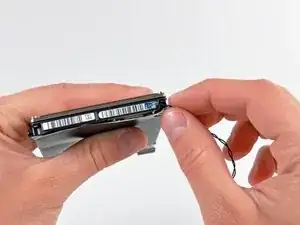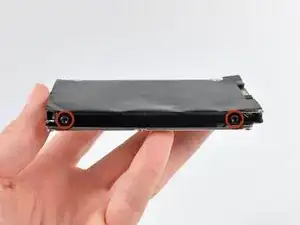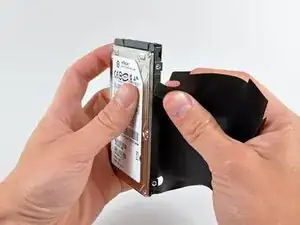Einleitung
Diese Anleitung hilft dir, die Festplatte deines Mac mini Mitte 2010 zu tauschen. Während der Anleitung wird etwas Kleber für die Befestigung des Temperatursensors an der neuen Festplatte benötigt.
Werkzeuge
Ersatzteile
-
-
Lege deine Daumen in die Vertiefungen der unteren Abdeckung.
-
Drehe die untere Abdeckung entgegen dem Uhrzeigersinn, bis der weiße Markierungspunkt am Rand der Abdeckung dem kleinen Kreis am Gehäuse gegenübersteht.
-
-
-
Neige den Mac Mini etwas, um die Abdeckung vom Gehäuse abzunehmen.
-
Entferne die Abdeckung und lege sie zur Seite.
-
-
-
Der Lüfter ist mit zwei 11,3 mm T6 Torx Schrauben in der Nähe der Antennenplatine am Logic Board befestigt. Drehe sie heraus.
-
-
-
Hebe die Ausbuchtung am Lüfter, der dem RAM am nächsten ist, aus dem Abstandshalter am hinteren Gehäuse.
-
-
-
Hebe den Lüfter ein Stück weit aus dem Mini, um an seinen Stecker zu gelangen.
-
Ziehe die Lüfterkabel vorsichtig nach oben, um den Stecker des Lüfters aus seinem Sockel auf dem Logic Board zu ziehen.
-
Entferne den Lüfter.
-
-
-
Hebe die Kühlhaube am Ende in der Nähe der Antennenplatte hoch.
-
Drehe die Haube weg vom Gehäuse und entferne sie vom Mini.
-
-
-
Die Antennenplatte ist mit vier Torx Schrauben am Mini befestigt. Drehe sie heraus:
-
Zwei 6,6 mm T8 Schrauben
-
Zwei 5,0 mm T8 oder 2,0 mm Inbus Schrauben
-
-
-
Hebe die Antennenplatte am Rand in der Nähe des RAM etwas an.
-
Ziehe die Platte sorgfältig weg vom runden Rand des äußeren Gehäuses.
-
-
-
Löse den Verbinder der Antenne vorsichtig mit der Spudgerspitze von der AirPort /Bluetooth Karte.
-
-
-
Entferne folgende drei Torx Schrauben:
-
Eine 5,0 mm T8 oder 2 mm Inbus Schraube
-
Eine 16,2 mm T6 Schraube
-
Eine 26 mm T6 Abstandsschraube
-
-
-
Ziehe sorgfältig an den Drähten der beiden Thermosensorkabels an der Festplatte, um ihre Stecker aus den jeweiligen Sockeln auf dem Logic Board zu lösen.
-
-
-
Löse die Verbinder von Festplatte und optischem Laufwerk mit dem flachen Ende des Spudgers aus ihren Sockel auf dem Logic Board.
-
-
-
Setze das Mac Mini Logic Board Removal Tool in die beiden rot markierten Löcher ein. Schiebe es durch, bis es das äußere Gehäuse unter dem Logic Board berührt, das ist wichtig, bevor du weitermachst.
-
Ziehe das Werkzeug vorsichtig in Richtung der I/O Platine. Diese Platine und das Logic Board sollten etwas aus dem äußeren Gehäuse rutschen.
-
Höre auf zu hebeln, sobald die I/O Platine sichtbar vom Gehäuse getrennt ist. Entferne das Removal Tool.
-
-
-
Drücke gleichzeitig die zwei Plastikrasten ganz rechts und links am I/O Board in Richtung Mitte und ziehe das I/O Board etwas vom äußeren Gehäuse weg.
-
-
-
Hebe die Festplatte am Rand gleich am Logic Board hoch und entferne sie vom Mini. Achte dabei auf den RAM Sockel und darauf, dass sich keine Kabel verfangen.
-
-
-
Entferne das Festplattenkabel, indem du es von der Festplatte gerade nach hinten abziehst.
-
-
-
Entferne das Klebeband, welches den Temperatursensor an der Seite der Festplatte bedeckt.
-
-
-
Entferne vorsichtig die angeklebte Hülle von der Festplatte.
-
Übrig bleibt die Festplatte.
-
Arbeite die Schritte in umgekehrter Reihenfolge ab, um dein Gerät wieder zusammenzubauen.
36 Kommentare
These instructions and a little common sense can also be used to replace the lower hard drive in the server version of the Mac Mini. Luckily that was the drive that had failed in my case. Replacing the upper drive looks like a tougher proposition.
Fantastic guide, thank you very much Mr. Bookholt!
As with the above commenter, I accidentally mistook the fan's standoff for a screw and removed it while removing the fan. Also the top right fan screw's standoff came out along with it. I edited the guide with a note on this.
While replacing the antenna, it wasn't immediately clear why the screws weren't lining up, until I realized that two of the screws were in the (otherwise free-floating but for the back grommets) hard drive, I also added a note on that.
STEP 15: If you don't have the time to purchase the Mac Mini Logic Board Removal Tool, the round stock on a large binder clip is PERFECT for the job. It requires a little bending and cutting but it worked perfectly!!
And as jon jon stated, it works like a lever - not a pull. You can feel it kind of click in to the lever points below.
Bravo to ifixit.com for the easy to follow instruction!!
blavin -
